Before we got on to the more usual Arctic metrics let’s bear in mind that the beginning of May is the time when the ice on the mighty Mackenzie River begins to break up, ultimately sending a surge of (comparatively!) warm water rushing into the Beaufort Sea. The patches of open water visible in the Beaufort Sea off the Mackenzie Delta in early April refroze, but have recently opened up once again:
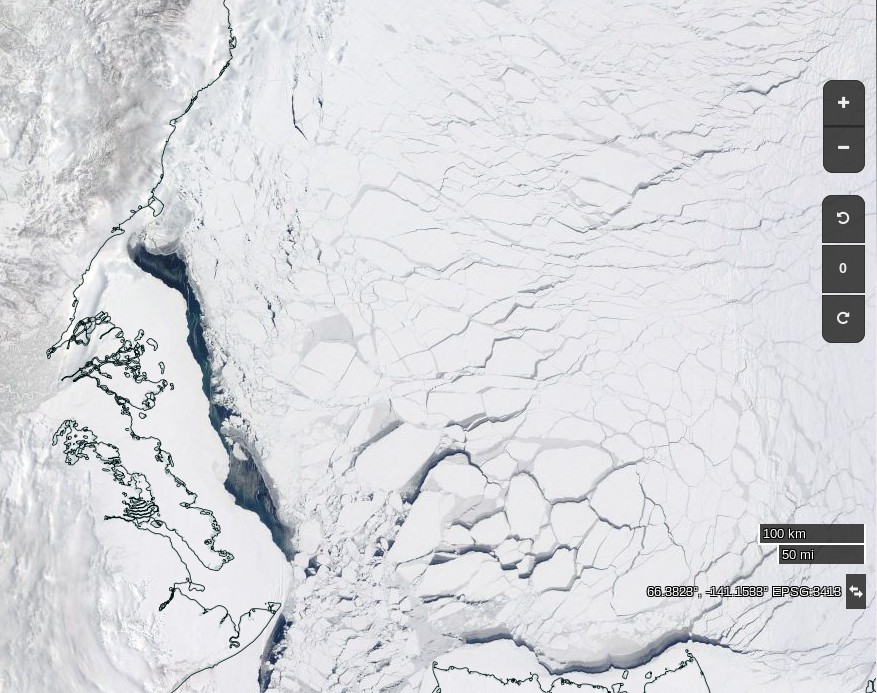
Meanwhile Northern Hemisphere snow cover is falling fast, albeit still above last year’s levels:
Here’s the current view of the Liard River in northern Canada, with the Mackenzie River running bottom to top on the right hand side:

The break-up of the Liard leads the Mackenzie, and taking a look at last year’s view of the same area it’s apparent that this year there’s somewhat more snow on the ground, and that this years Mackenzie break-up will therefore be a few days later than last year:
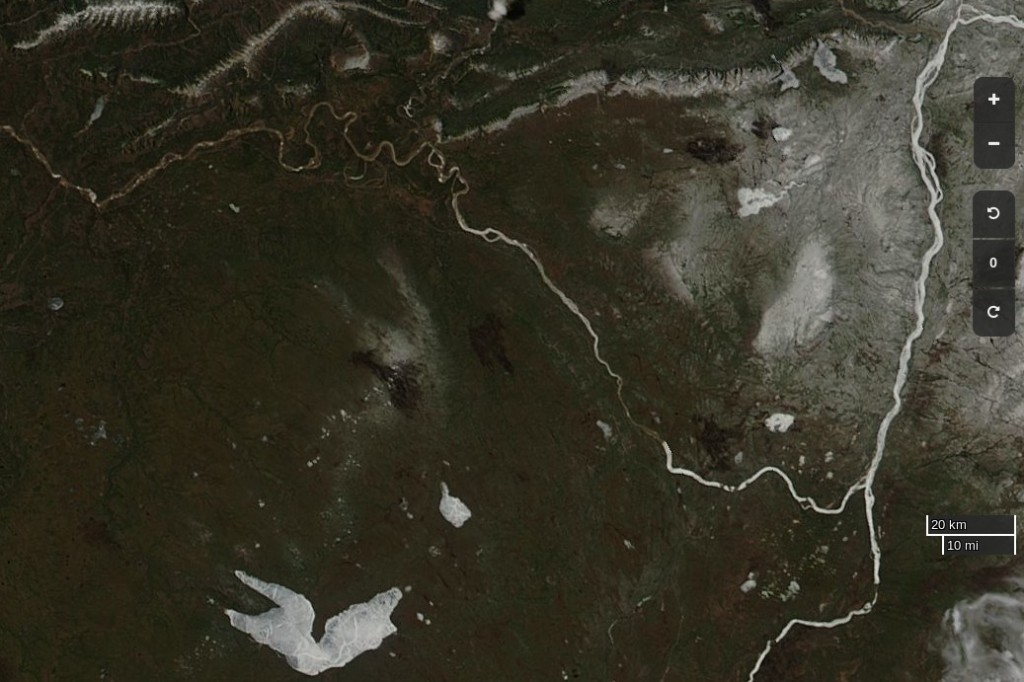
Whilst early melt in the Beaufort Sea is currently behind last year, the reverse is most certainly the case next door in the Chukchi Sea. The skies are rather cloudy there at the moment, but using the Suomi NPP day/night band to peer through the gloom reveals this:
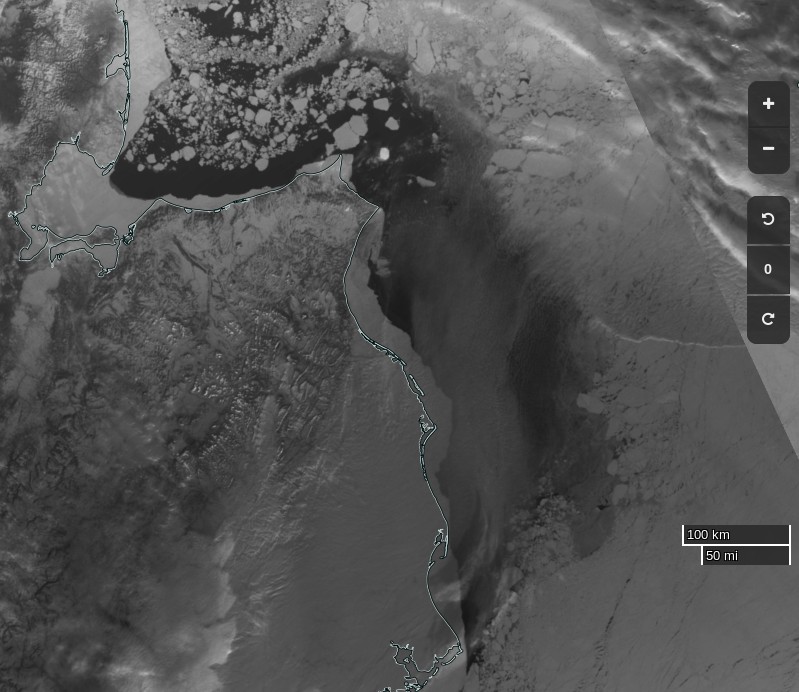
Whilst sea coverage on the Pacific periphery has continued to fall, extent on the Atlantic side has not been following suit. Hence overall Arctic sea ice area is no longer lowest in the satellite record:
Finally, until the new PIOMAS numbers are released at least, here’s how DMI freezing degree days look at the moment:
The April PIOMAS numbers have been published: Arctic sea ice volume is yet again by far the lowest on record:
Greenland ice sheet surface melt has started early this year:
The ice break-up of the Mackenzie River is now visible as increased flow at the junction with Arctic Red River just south of the delta:
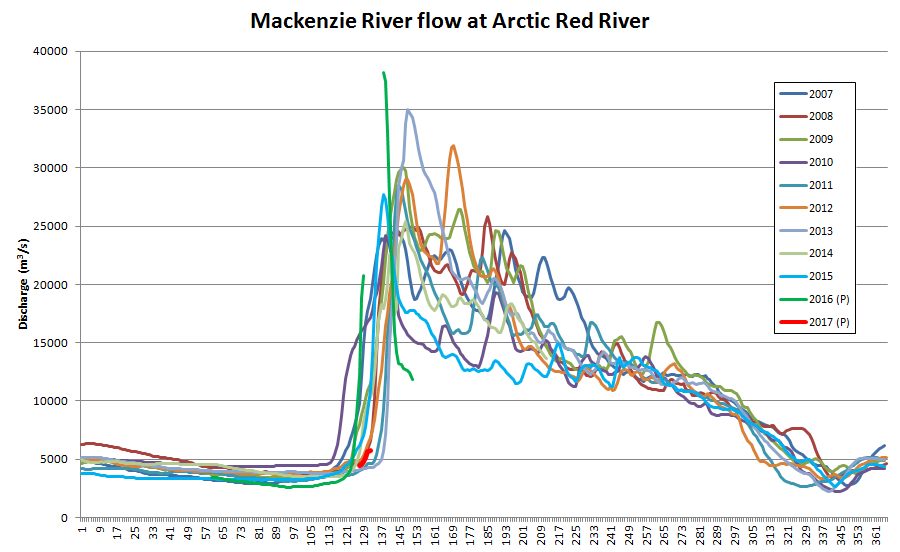
Meanwhile the sea ice in the Lincoln Sea north the Nares Strait is coming apart at the seams:
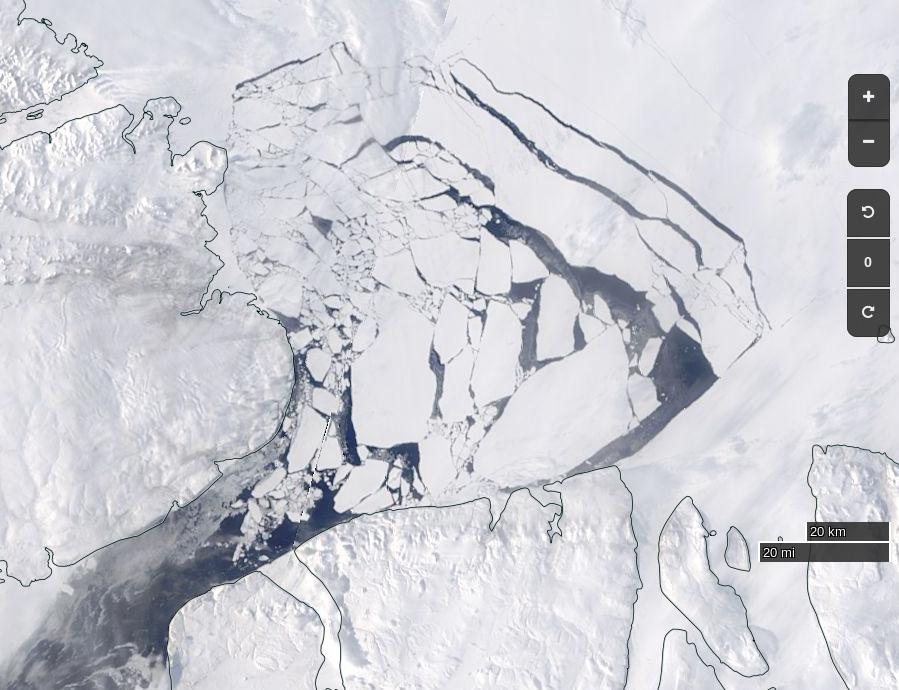
May seems to be shaping up as month of two halves, both spatially and temporally. Here’s an overview of the current state of play:
On the Pacific side of the Arctic sea ice area has been declining rapidly courtesy of the expanding areas of open water visible in the Beaufort, Chukchi and East Siberian Seas. It’s currently tracking below other recent years:
However over on the Atlantic side area has been flatlining, and is currently above other recent years:
Ice mass balance buoy 2017A is now located near the boundary between the Beaufort and Chukchi Seas and as the melting season in that vicinity rapidly approaches it reveals that thermodynamic thickening has thus far achieved a mere 119 cm: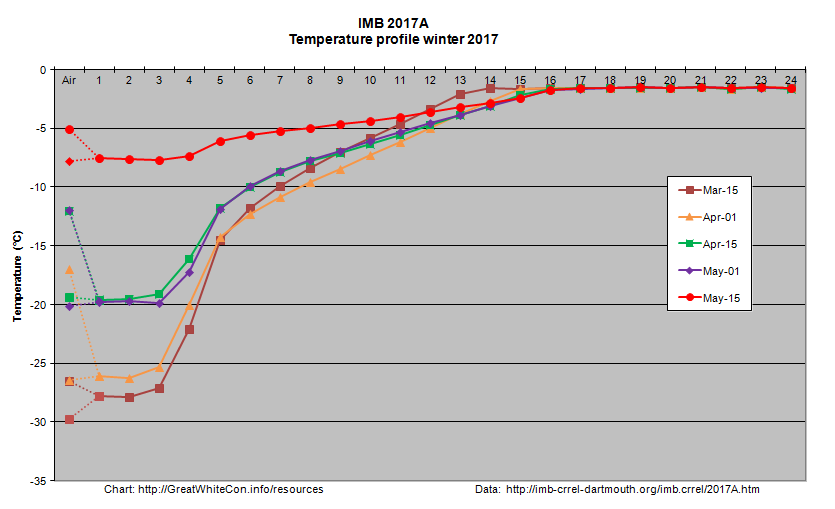
Arctic wide sea ice area has recently started to decline at an increasing rate:
During the second half of the month it will be interesting to see whether the forecast high temperatures produce significant melt ponding. If so it’s conceivable that 2017 area could drop below 2016 again by the beginning of June. There already signs of surface melt at places as far apart as Franklin Bay, Chaunskaya Bay and even the Great Bear Lake!
Watch this space!
References
Muhammad, P., Duguay, C., and Kang, K.-K.: Monitoring ice break-up on the Mackenzie River using MODIS data, The Cryosphere, 10, 569-584, doi:10.5194/tc-10-569-2016, 2016.
Rood S. B., Kaluthota S., Philipsen L. J., Rood N. J., and Zanewich K. P. (2017) Increasing discharge from the Mackenzie River system to the Arctic Ocean, Hydrol. Process., 31, 150–160. doi: 10.1002/hyp.10986.
Kwok, R., L. Toudal Pedersen, P. Gudmandsen, and S. S. Pang (2010), Large sea ice outflow into the Nares Strait in 2007, Geophys. Res. Lett., 37, L03502, doi:10.1029/2009GL041872.
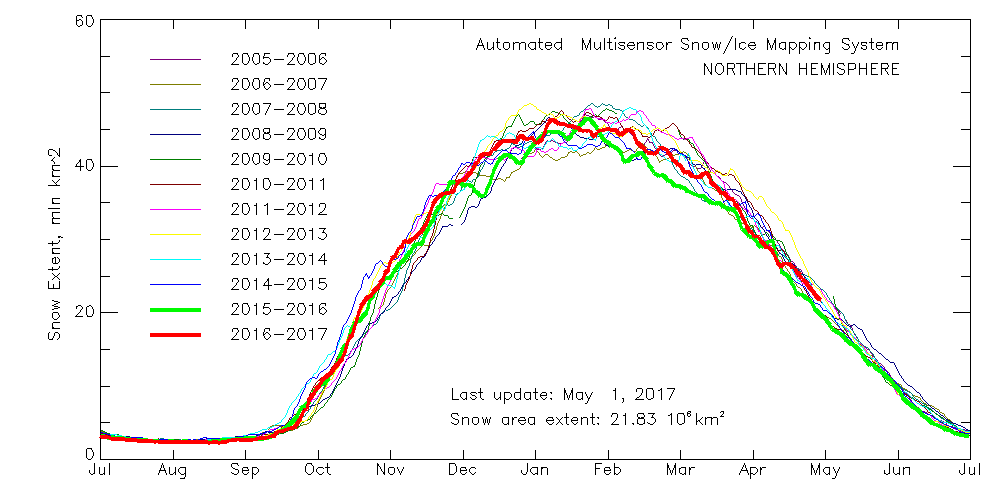

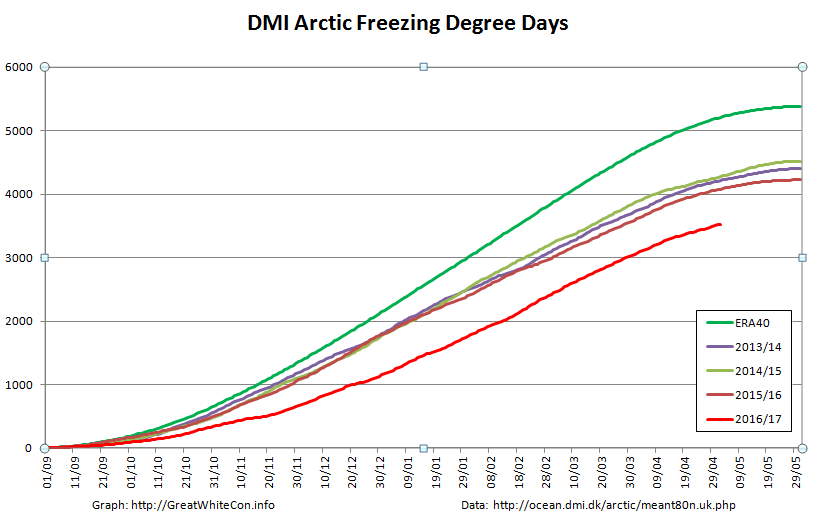
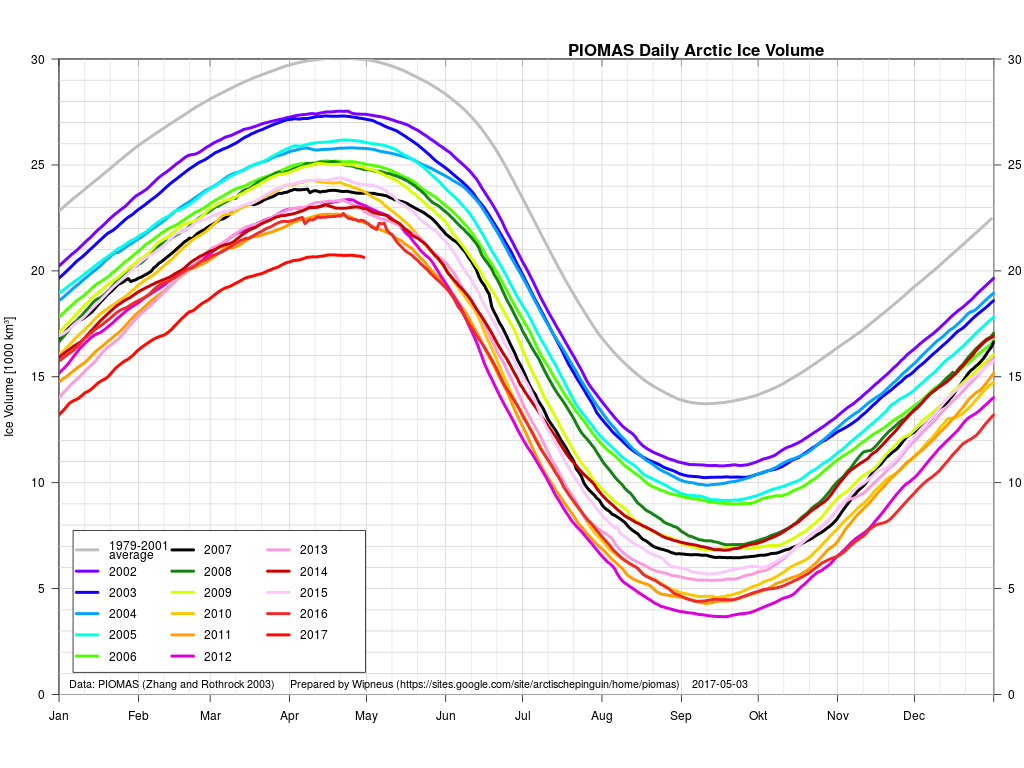

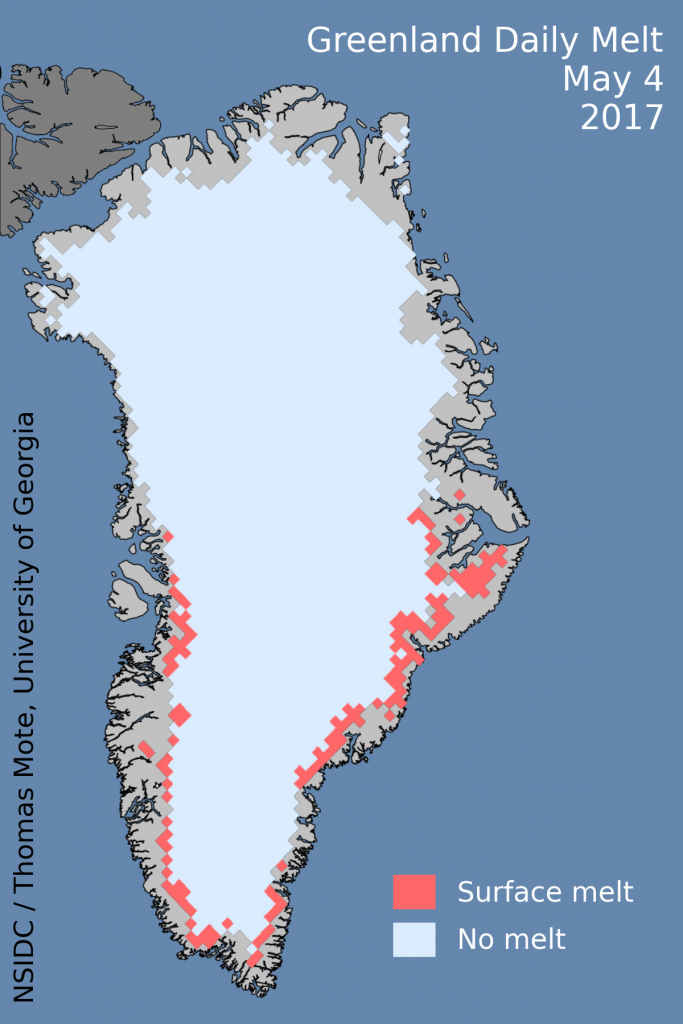
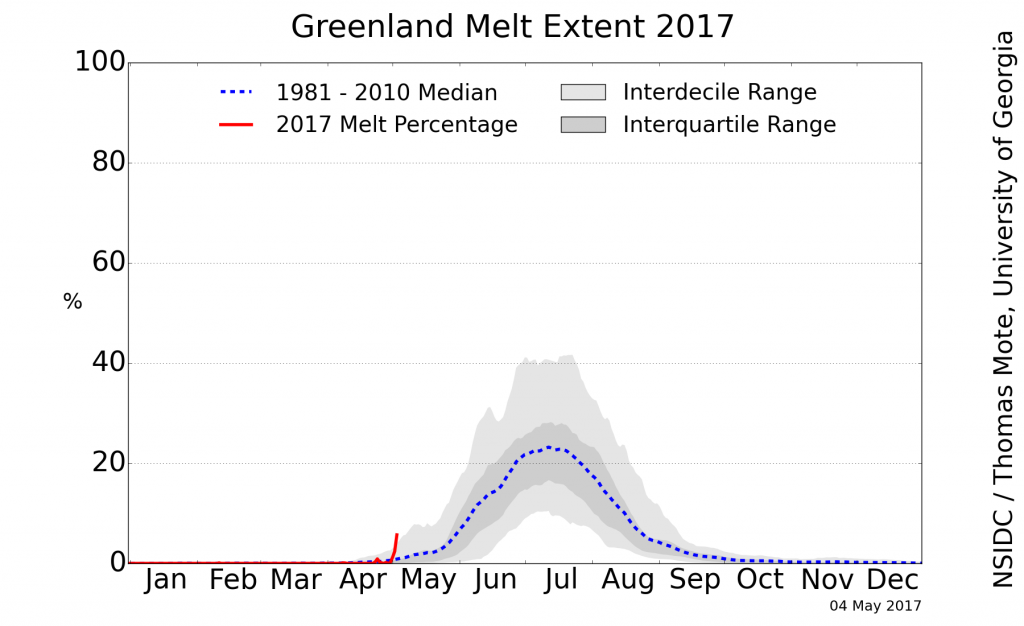
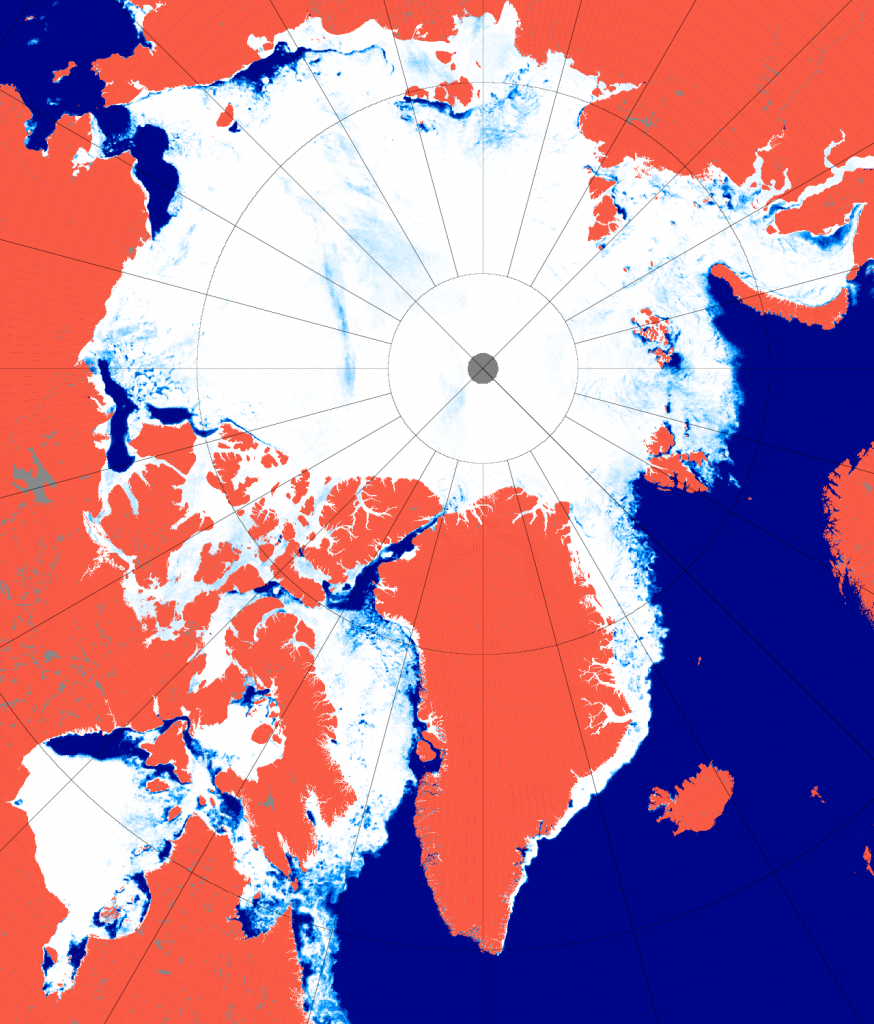
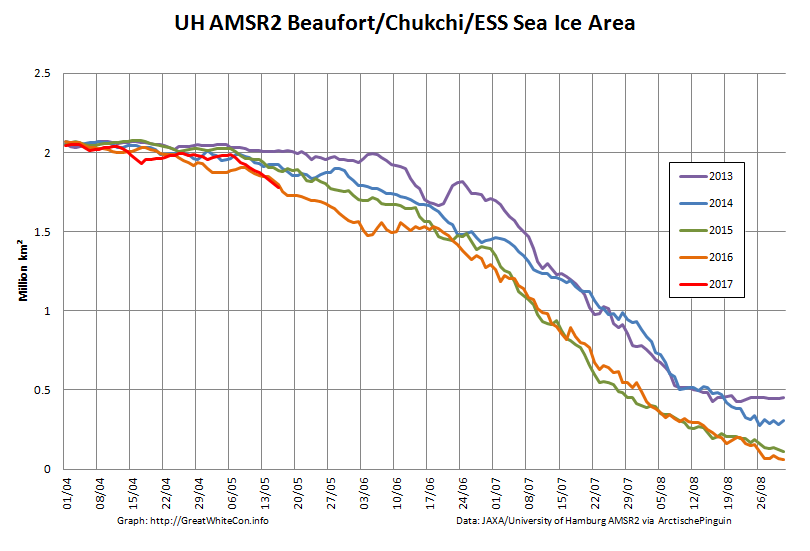
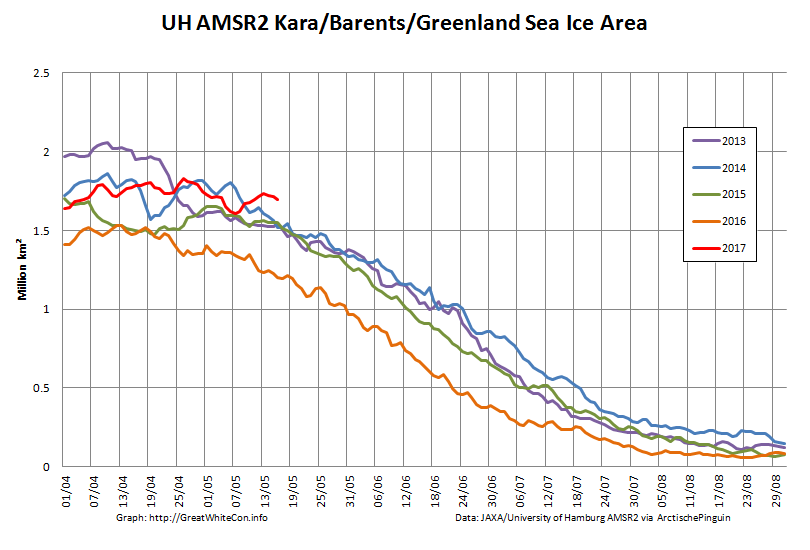

The Liard River is now ice free, and break-up has started on the Mackenzie River:
I take it this is not early behaviour?!!?
It is not. See the Mackenzie River flow graph above. This year’s start is behind most recent years. However it looks as though things will speed up now:
Temperatures are above normal across the Mackenzie catchment and the Beaufort Sea, and are predicted to remain so for quite a while:
However the break-up of the northern Nares Strait arch is well ahead of “normal”, and the southern arch has been conspicuous by its absence for quite some time!
Looking forward to your next update. Things seem to have stalled a bit (temps below normal, ice extent and area decreasing at a slower than normal rate, Mackenzie delta still plugged up, etc. Very curious about your take on what’s happening and what impact you think that might have for September.
No sooner said than done Taylor! See above. Things are warming up in the Arctic, literally and metaphorically.
Although the Mackenzie break-up was a few days behind last year the flow towards the Beaufort Sea is increasing rapidly now:
Two things to watch for are whether melt ponding by the end of May matches 2012, and what happens when all the ice that’s been exported from the Central Arctic in the direction of the North Atlantic starts to melt in earnest. Here’s JAXA’s version of the current state of play in that regard:
Can that above JAXA graphic confirm whether or not 2016 was infact a very bad year for the myi?
KrisVan Steenbergen from twitter was basically telling me myi melts anyway so I am not sure whether it is confirmed or denied that 2016 was infact a very bad year for the myi… basically it seems like we are still waiting on that verdict with the way this years melt goes.
Not IMHO. I take JAXA’s thickness algo with a very large pinch of salt. See for example the way things change from one day to the next.
Here’s NSIDC’s recent verdict on MYI:
That doesn’t suggest that 2016 was “a very bad year for the MYI”, area wise at least.
No it doesn’t seem to at all: but the world at large appreciates the worlds best analysis as we all known stagnation can lead to death so it is always best to be prepared. The masses may be slandered as dumb but it is that exact spark that gave us what we all have today!
Indicators are sure to be hotly observed these coming days and we all thank you(,… lol, like I represent them all ~;^>’////<) !!
Thanks for the reply, and here’s another quick question. You say in the post above that there are forecast high temperatures for May that could affect melt pounding. While the temperature is going up, per DMI at least, temps above 80 degrees are remaining below normal. Is that what you’re seeing in other data, and what effect might that have on the ice overall? Some maps also seem to show thick ice near the Mackenzie delta outlet – is that the case, and does that mean the flow is submarining under the existing ice?
Thanks for patience with me in these topics.
It’s too early yet for melt ponding to set in north of 80 degrees. The $64,000 question at the moment is when they arrive north of 70 degrees. O-Buoy 14 in the depths of the Northwest Passage currently reports temperatures above freezing:
However her webcam seems to be shrouded in mist at the moment, and the ice surface is invisible! Even as we speak temperatures above zero are spreading out across the Beaufort Sea, and into the Central Arctic.
Meanwhile there’s currently plenty of freshly melted water heading down the Mackenzie River towards the Beaufort Sea:
Whilst I imagine some of it travels under the ice some of it certainly also goes over the ice:
AbbottisGone @AbbottisGone May 21
More
AbbottisGone Retweeted Kris Van Steenbergen
This can’t be a serious prediction for this September can it? AbbottisGone added,
Kris Van Steenbergen @KrVaSt
Prediction made after 10 years of monitoring.
Chances of a sea ice free Arctic in 2017:
< 1.000.000 km²: 99%
< 500.000 km²: 95%…
1 reply 0 retweets 0 likes
Reply 1 Retweet
Like View Tweet activity
Kris Van Steenbergen
@KrVaSt
Following
More
Replying to @AbbottisGone
I'm afraid it does…
11:56 PM – 21 May 2017
0 replies 0 retweets 0 likes
Reply Retweet
Like Direct message
<<
Here I refused to believe this guys( Kris Van Steenbergen
@KrVaSt ) predictions from whatever the source he got it from (I didn't check, I just refuted the allegation!) but he insisted with his 'following' retweeted statement to my 'added' retweeted statement that:
"I'm afraid it does…"
<<
What do you think?
I think Kris is mistaken.
Let’s compare notes in September shall we?
I thought he was,.. but I still look at some of his posts so I was a bit confused why he posted that.
Agree, given stubborn ice on the Atlantic side (lower water temps?), and slightly cooler air temps above 80 degrees north, May has slowed, with NSIDC creeping toward 2SD of normal. I think we are in for a rebound year – not as significant as the 2013 rebound, but certainly well above 2016. Would be interested in his reasoning beyond “afraid so”.
Look him up: he’s on twitter!
Jim, The Polar Portal sea ice thickness map is showing most of the 5 m thick or more sea ice off the cost of Baffin. Is this believable?
Sorry, that wasn’t very clear: I mean that, according to the Polar Portal graphic, most of what remains of 5 m thick ice is, according to polar portal off the coast of Baffin, and not north of Greenland/Ellesmere Island. Very odd….
Until you pointed it out I hadn’t noticed the supposedly extra thick ice in Foxe Basin on DMI’s thickness map, which I assume is what you’re referring to?
I find it very hard to believe, and so do the Canadian Ice Service!
Jim, that’s exactly the area that I was referring to, though there’s also some very thick ice shown a bit further west in the archipelago, which also looks very strange. I’m inclined to believe the Canadians here rather than the Danes.
Excellent resources on your blog, by the way.
Would it be fair to say, that while Arctic ice levels are still at record lows, we can see that now there is potential for a rebound this year?
Whilst everything still depends on the weather over the next few months I personally don’t see much potential for a significant “rebound” this summer, and certainly nothing along the lines of 2013.
For example, even after a “coolish” May PIOMAS volume is still well below all previous years in their records.